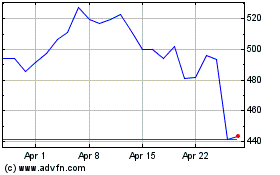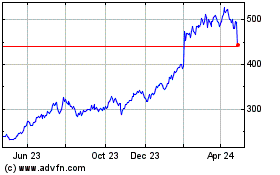Facebook Simplifies Metrics After Data-Reporting Issues, Advertiser Confusion
February 22 2018 - 2:01PM
Dow Jones News
By Alexandra Bruell
Facebook is trying to clarify and simplify the metrics used to
gauge the performance of advertising on its platform after coming
under scrutiny for a series of measurement mishaps and learning
that some people are confused about its data.
On Thursday, the company announced plans to more clearly label
certain metrics after confirming that some advertisers were
confused about which metrics were estimates based on sampling and
modeling, versus actually counted data. "Estimated" labels will now
appear on ad products in the company's Ads Manager system to alert
advertising clients.
Other metrics that are still in development will be labeled as
such to make it clear that they are new or in testing and could
change.
"We want to be transparent around how things are calculated,"
said Brad Smallwood, vice president of marketing science at
Facebook.
The company also announced plans to get rid of 20 metrics --
amounting to about 10% of its metrics -- that weren't frequently
used by or useful to advertisers. Mr. Smallwood described these
metrics as redundant and outdated.
Facebook is taking steps to appease advertisers after
acknowledging over the past year and a half several discrepancies
or flaws in its data, which undermined marketers' trust in the
company's data-reporting practices. In the wake of those errors,
Facebook agreed to undergo audits by the media industry's
measurement watchdog, the Media Rating Council, a year ago.
Facebook said the new metrics changes were spurred, in part, by
the discovery that advertisers aren't fully aware that some metrics
are estimates or may be still be in the development phase.
Mr. Smallwood said the company's decision to refine its labeling
was also influenced by news reports last year that Facebook claimed
to reach millions more users among specific age groups in the U.S.
than actually reside in the country, according to official census
data.
"We always said it was estimated," but "people didn't know it,"
he said. "We realize we need to do a better job and be super clear
when things are estimated."
Ad industry folks were also confused, Facebook found.
For example, a number of ad buyers and marketers thought the
company's reach data, which measures the number of unique
individuals who saw an ad, was an actual count rather than an
estimate, he said. It's easy to count how many times an ad is
viewed, but calculating the number of unique individuals exposed to
the ad is complicated, he said.
Facebook's reach estimate is mainly to help marketers plan their
ad campaigns and doesn't affect how advertisers are billed by
Facebook.
Facebook recently quizzed advertisers and agencies that make up
its measurement council on what metrics are estimated versus
actual. When the reach metric came up, around half of the attendees
were uncertain, said Ed Gaffney, director of implementation
research at WPP ad buying network GroupM and a member of Facebook's
measurement council.
Write to Alexandra Bruell at alexandra.bruell@wsj.com
(END) Dow Jones Newswires
February 22, 2018 13:46 ET (18:46 GMT)
Copyright (c) 2018 Dow Jones & Company, Inc.
Meta Platforms (NASDAQ:META)
Historical Stock Chart
From Mar 2024 to Apr 2024

Meta Platforms (NASDAQ:META)
Historical Stock Chart
From Apr 2023 to Apr 2024
